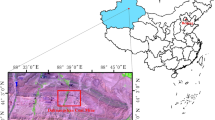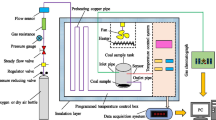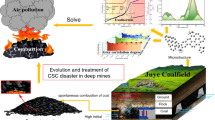Abstract
The effects of crude oil on the microstructure and spontaneous combustion characteristics of coal were assessed, using raw coal sample and coal samples containing 5%, 10% and 15% oil. The pore structures, oxygen adsorption capacity, surface functional groups and spontaneous combustion characteristics were characterized by the LP-N2A, TG, FTIR and temperature-programmed experiments. The LP-N2A and TG tests revealed that the presence of crude oil reduced the porosity, specific surface area and pore volume in the coal sample containing crude oil, which would suppress the transport capacity of oxygen in mesopores and micropores not to adsorb on the specific active sites of coal surfaces. FTIR analysis indicated that the amount of oxygen-containing functional groups and –OH groups decreased tremendously in the coals containing crude oil, but the content of aliphatic C–H groups showed an increasing trend. Moreover, the values of A(CH2)/A(CH3), Ahy/Aar, Aoxygen/Aar all decrease gradually with the rising crude oil contents, indicating that the crude oil reduced the average alkyl chain length and compressed the space between aromatic clusters. The results of temperature-programmed experiments showed that O2 consumption and CO production rates decreased gradually with the increase in crude oil content. The results were in agreement with the varying trend of characterization of microstructure and function groups obtained by LP-N2A, TG and FTIR tests. Furthermore, the Pearson correlation coefficient cleared that the breaking of long aliphatic chains of aromatic rings and reduction of hydrogen bonds content have a greater contribution to the suppression of spontaneous combustion than the attenuation of physical adsorption. This study concluded that crude oil lowers down the spontaneous combustion properties of coal, which could provide a reference for the prevention of spontaneous combustion of coal seam containing crude oil.












Similar content being viewed by others
References
Wessling S, Kuenzer C, Kessels W, Wuttke MW. Numerical modeling for analyzing thermal surface anomalies induced by underground coal fires. Int J Coal Geol. 2008;74(3–4):175–84.
Xia T, Zhou F, Wang X, Kang J, Pan Z. Safety evaluation of combustion-prone longwall mining gobs induced by gas extraction: a simulation study. Process Saf Environ Prot. 2017;109:677–87.
Cheng W, Hu X, Zhao Y, Wu M, Hu Z, Yu X. Preparation and swelling properties of poly(acrylic acid-co-acrylamide) composite hydrogels. e-Polymers. 2017;17(1):95–106.
Wen H, Fan S, Zhang D, Wang W, Guo J, Sun Q. Experimental study and application of a novel foamed concrete to yield airtight walls in coal mines. Adv Mater Sci Eng. 2018;2018:1–13.
Stracher GB. Coal fires burning around the world: a global catastrophe. Int J Coal Geol. 2004;59(1–2):1–6.
Zhou FB. Study on the coexistence of gas and coal spontaneous combustion(I):disaster mechanism. J China Coal Soc. 2012;19(37):143–204.
Jin YF, Li H, Xu Y. Spontaneous combustion parameters test of Huangling coal samples based on heating experiments of a small coal sample oxidation of natural insulation. Coal Technol. 2014;142–144.
Deng J, Lei C, Xiao Y, Cao K, Ma L, Wang W, et al. Determination and prediction on “three zones” of coal spontaneous combustion in a gob of fully mechanized caving face. Fuel. 2018;211:458–70.
Stracher GB, Taylor TP. Coal fires burning out of control around the world: thermodynamic recipe for environmental catastrophe. Int J Coal Geol. 2004;59(1–2):7–17.
Song Z, Kuenzer C. Coal fires in China over the last decade: a comprehensive review. Int J Coal Geol. 2014;133:72–99.
Cheng W, Hu X, Xie J, Zhao Y. An intelligent gel designed to control the spontaneous combustion of coal: fire prevention and extinguishing properties. Fuel. 2017;210:826–35.
Zhang YT, Yang CP, Li YQ, et al. Ultrasonic extraction and oxidation characteristics of functional groups during coal spontaneous combustion. Fuel. 2019;242:287–94.
Xi Z, Wang X, Wang X, Wang L, Li D, Guo X, et al. Self-hardening thermoplastic foam for the inhibition of coal oxidation at low temperatures. Combust Sci Technol. 2018;142–144:1–18.
Wang H, Dlugogorski BZ, Kennedy EM. Coal oxidation at low temperatures: oxygen consumption, oxidation products, reaction mechanism and kinetic modelling. Prog Energy Combust Sci. 2003;29(6):487–513.
Qi X, Li Q, Zhang H, Xin H. Thermodynamic characteristics of coal reaction under low oxygen concentration conditions. J Energy Inst. 2017;90(4):544–55.
Wang D, Xin H, Qi X, Dou G, Qi G, Ma L. Reaction pathway of coal oxidation at low temperatures: a model of cyclic chain reactions and kinetic characteristics. Combust Flame. 2016;163:447–60.
Zhao CL, Sun YZ, Xiao L, Qin SJ, Wang JX, Duan DJ. The occurrence of barium in a Jurassic coal in the Huangling 2 Mine, Ordos Basin, northern China. Fuel. 2014;128:428–32.
Tang Y, Li Y, Xue S, Wang J, Li R. Experimental investigation of long-term water immersion effect on spontaneous combustion parameters and microscopic characteristics of bituminous. J China Coal Soc. 2017;42(10):2642–8.
Wang H, Dlugogorski BZ, Kennedy EM. Analysis of the mechanism of the low-temperature oxidation of coal. Combust Flame. 2003;134(1–2):107–17.
Wang D, Dou G, Zhong X, Xin H, Qin B. An experimental approach to selecting chemical inhibitors to retard the spontaneous combustion of coal. Fuel. 2014;117:218–23.
Su H, Zhou F, Li J, Qi H. Effects of oxygen supply on low-temperature oxidation of coal: a case study of Jurassic coal in Yima, China. Fuel. 2017;202:446–54.
Wang X, Luo Y, Vieira B. Experimental technique and modeling for evaluating heat of rewetting effect on coals’ propensity of spontaneous combustion based on adiabatic oxidation method. Int J Coal Geol. 2018;187:1–10.
Zhang Y, Wu J, Chang L, Wang J, Xue S, Li Z. Kinetic and thermodynamic studies on the mechanism of low-temperature oxidation of coal: a case study of Shendong coal (China). Int J Coal Geol. 2013;120:41–9.
Lu Y, Shi S, Wang H, Tian Z, Ye Q, Niu H. Thermal characteristics of cement microparticle-stabilized aqueous foam for sealing high-temperature mining fractures. Int J Heat Mass Transf. 2019;131:594–603.
Senneca O, Cortese L. Kinetics of coal oxy-combustion by means of different experimental techniques. Fuel. 2012;102:751–9.
Nie B, Liu X, Yang L, Meng J, Li X. Pore structure characterization of different rank coals using gas adsorption and scanning electron microscopy. Fuel. 2015;158:908–17.
Tang Z, Yang S, Zhai C, Xu Q. Coal pores and fracture development during CBM drainage: their promoting effects on the propensity for coal and gas outbursts. J Nat Gas Sci Eng. 2018;51:9–17.
Xiao Y, Lü H-F, Huang A-C, Deng J, Shu C-M. A new numerical method to predict the growth temperature of spontaneous combustion of 1/3 coking coal. Appl Therm Eng. 2018;131:221–9.
Deng J, Li Q, Xiao Y, Wen H. The effect of oxygen concentration on the non-isothermal combustion of coal. Thermochim Acta. 2017;653:106–15.
Li B, Chen G, Zhang H, Sheng C. Development of non-isothermal TGA–DSC for kinetics analysis of low temperature coal oxidation prior to ignition. Fuel. 2014;118:385–91.
Qin L, Zhai C, Liu S, Xu J, Yu G, Sun Y. Changes in the petrophysical properties of coal subjected to liquid nitrogen freeze-thaw—a nuclear magnetic resonance investigation. Fuel. 2017;194:102–14.
Xu J, Zhai C, Liu S, Qin L, Wu S. Pore variation of three different metamorphic coals by multiple freezing-thawing cycles of liquid CO2 injection for coalbed methane recovery. Fuel. 2017;208:41–51.
Niu Q, Pan J, Jin Y, Wang H, Li M, Ji Z, et al. Fractal study of adsorption-pores in pulverized coals with various metamorphism degrees using N2 adsorption, X-ray scattering and image analysis methods. J Petrol Sci Eng. 2019;176:584–93.
Kaji RHY, Nakamura Y. Low temperature oxidation of coals: effects of pore structure and coal composition. Fuel. 1985;64:297–302.
Song H, Liu G, Zhang J, Wu J. Pyrolysis characteristics and kinetics of low rank coals by TG-FTIR method. Fuel Process Technol. 2017;156:454–60.
Zhang Y, Wang J, Xue S, Wu J, Chang L, Li Z. Kinetic study on changes in methyl and methylene groups during low-temperature oxidation of coal via in situ FTIR. Int J Coal Geol. 2016;154–155:155–64.
Zhao J, Deng J, Wang T, Song J, Zhang Y, Shu C-M, et al. Assessing the effectiveness of a high-temperature-programmed experimental system for simulating the spontaneous combustion properties of bituminous coal through thermokinetic analysis of four oxidation stages. Energy. 2019;169:587–96.
Pan J, Peng C, Wan X, Zheng D, Lv R, Wang K. Pore structure characteristics of coal-bearing organic shale in Yuzhou coalfield, China using low pressure N2 adsorption and FESEM methods. J Petrol Sci Eng. 2017;153:234–43.
Wen H, Xu J, Ge L. Experimental simulation and numerical analysis of coal spontaneous combustion process at low temperature. Int J Coal Sci Technol. 2001;2:61–6.
Deng J, Zhao J, Zhang Y, Huang A, Liu X, Zhai X, et al. Thermal analysis of spontaneous combustion behavior of partially oxidized coal. Process Saf Environ Prot. 2016;104:218–24.
Liu X, Nie B. Fractal characteristics of coal samples utilizing image analysis and gas adsorption. Fuel. 2016;182:314–22.
Shi Q, Qin B, Liang H, Gao Y, Bi Q, Qu B. Effects of igneous intrusions on the structure and spontaneous combustion propensity of coal: a case study of bituminous coal in Daxing Mine, China. Fuel. 2018;216:181–9.
Jiang J, Cheng Y, Wang L, Li W, Wang L. Petrographic and geochemical effects of sill intrusions on coal and their implications for gas outbursts in the Wolonghu Mine, Huaibei Coalfield, China. Int J Coal Geol. 2011;88(1):55–66.
Wen H, Fan S, Xiao J, Lu P, Guo J, Liu W, et al. Combustion kinetics of No. A3 coal in the Paner coal mine of the Huainan Coalfield, Anhui, China. Procedia Eng. 2018;2018(211):149–59.
He X, Liu X, Nie B, Song D. FTIR and Raman spectroscopy characterization of functional groups in various rank coals. Fuel. 2017;206:555–63.
Song H, Liu G, Wu J. Pyrolysis characteristics and kinetics of low rank coals by distributed activation energy model. Energy Convers Manag. 2016;126:1037–46.
Baysal M, Yürüm A, Yıldız B, Yürüm Y. Structure of some western Anatolia coals investigated by FTIR, Raman, 13C solid state NMR spectroscopy and X-ray diffraction. Int J Coal Geol. 2016;163:166–76.
Cui C, Jiang S, Zhang W. Influence of different concentrations of ionic solutions on coal spontaneous combustion. Combust Sci Technol. 2018;190(10):1817–31.
Cui F-S, Laiwang B, Shu C-M, Jiang J-C. Inhibiting effect of imidazolium-based ionic liquids on the spontaneous combustion characteristics of lignite. Fuel. 2018;217:508–14.
Orrego-Ruiz JA, Cabanzo R, Mejía-Ospino E. Study of Colombian coals using photoacoustic Fourier transform infrared spectroscopy. Int J Coal Geol. 2011;85(3–4):307–10.
Wu D, Liu G, Sun R, Fan X. Investigation of structural characteristics of thermally metamorphosed coal by FTIR spectroscopy and X-ray diffraction. Energy Fuels. 2013;27(10):5823–30.
Jing Z, Rodrigues S, Strounina E, Li M, Wood B, Underschultz JR, et al. Use of FTIR, XPS, NMR to characterize oxidative effects of NaClO on coal molecular structures. Int J Coal Geol. 2019;201:1–13.
Yuan S, Liu J, Zhu J, Zhou Q, Wang Z, Zhou J, et al. Effect of microwave irradiation on the propensity for spontaneous combustion of Inner Mongolia lignite. J Loss Prev Process Ind. 2016;44:390–6.
Wen H, Xu J, Li L, Dai A. Analysis of coal self-ignite heat accumulating process and its effect factor. J China Coal Soc. 2003;28(4):370–4.
Wen H, Yu Z, Fan S, Zhai X, Liu W. Prediction of spontaneous combustion potential of coal in the gob area using CO extreme concentration: a case study. Combust Sci Technol. 2017;189(10):1713–27.
Shi Q, Qin B, Bi Q, Qu B. An experimental study on the effect of igneous intrusions on chemical structure and combustion characteristics of coal in Daxing Mine, China. Fuel. 2018;226:307–15.
Tang Y, Wang H. Experimental investigation on microstructure evolution and spontaneous combustion properties of secondary oxidation of lignite. Process Saf Environ Prot. 2019;124:143–50.
Acknowledgements
The authors gratefully acknowledge the financial support from National Natural Science Foundation of China (Grant Nos. 51974240, 51804245 and 51904234) and National Key Research and Development projects of China (Grant Nos. 2016YFC0801802, 2018YFC0808201).
Author information
Authors and Affiliations
Corresponding author
Ethics declarations
Conflict of interest
The authors declare that they have no known competing financial interests or personal relationships that could have appeared to influence the work reported in this paper.
Additional information
Publisher's Note
Springer Nature remains neutral with regard to jurisdictional claims in published maps and institutional affiliations.
Rights and permissions
About this article
Cite this article
Fan, S., Wen, H., Zhang, D. et al. Effects of crude oil on the microstructure and spontaneous combustion characteristics of coal: a case study of weakly caking coal in the Huangling No. 2 mine, China. J Therm Anal Calorim 144, 539–551 (2021). https://doi.org/10.1007/s10973-020-10092-4
Received:
Accepted:
Published:
Issue Date:
DOI: https://doi.org/10.1007/s10973-020-10092-4




